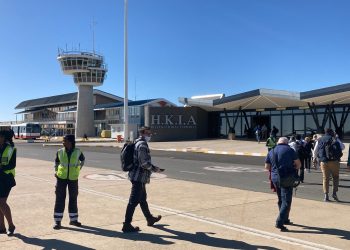
The Namibian Ports Authority handled 7,691,781 tonnes of cargo during the year ended 31 March 2023, a record-breaking amount from prior years.
The current volume marks a significant increase compared to the 6,576,370 tonnes of cargo handled in the previous financial year, with a 17% year-on-year increase in cargo handling.
NamPort Manager for Corporate Communications Tana Pesat attributed the increase to “the exportation of various goods, including salt, base metals, coal, copper concentrate, copper, ship spares, other minerals, sulphur, frozen fish, petroleum products, and lubricating oil, which recorded a notable 44% increase compared to the previous financial yearâ€.
She said there was also a commendable 9% increase in the importation of goods during the financial year under review.
The number of vessels calling Namibian ports also increased by 3%, resulting in 44 additional port calls.
“The increase was attributed to greater calls by dry bulk, petroleum, passenger, reefer, patrol, and research vessels, with the vessels’ gross tonnages increasing by 2.9 million tonnes or 14.9% compared to the previous financial year,” Pesat said.
Similarly, the financial year also recorded an increased occupancy rate of the Syncrolift facilities, with the repair jetties’ occupancy rising from 54% to 64%, and the repair bays’ occupancy increasing from 47% to 52%.
Pesat commended NamPort’s committed workforce and the customers’ trust in using the Ports Authority’s amenities, which directly contributed to positive operations.
“NamPort continues to pursue its vision of becoming the best-performing seaports in Africa,” she said.
Similarly, the Walvis Bay Corridor Group (WBCG) also announced the corridor volumes and a sterling performance for the financial year 2022/23.
Corridor cargo volumes entering and leaving the hinterland increased by 50% year on year, climbing from 1,639,510 tonnes to 2,464,123 tonnes.
The CEO of WBCG, Mbahupu Hippy Tjivikua, said the significant growth of corridor volumes is testimony that their business development initiatives and trade facilitation efforts are making an impact in the target markets.
“This is a result of team efforts between ourselves, Namport and all the relevant stakeholders along the supply chain. Moreover, the clients in these markets are increasingly finding our trade routes very efficient and safer,” he said.
He added that although a few challenges remain, “great inroads have been made over the years, and this is all thanks to all our stakeholders’ support, input and commitment.”
The volumes throughput recorded are for the ports of Walvis Bay and Lüderitz, going to and coming from the target markets of Angola, Botswana, the Democratic Republic of the Congo (DRC), Malawi, South Africa, Zambia as well as Zimbabwe.Â
Prior to Namibia’s independence, there were absolutely no corridor volumes. The first cross-border cargo was only initially recorded in 2004.
According to the Group, the best performance was shown by the Botswana market with a growth of 285%.











